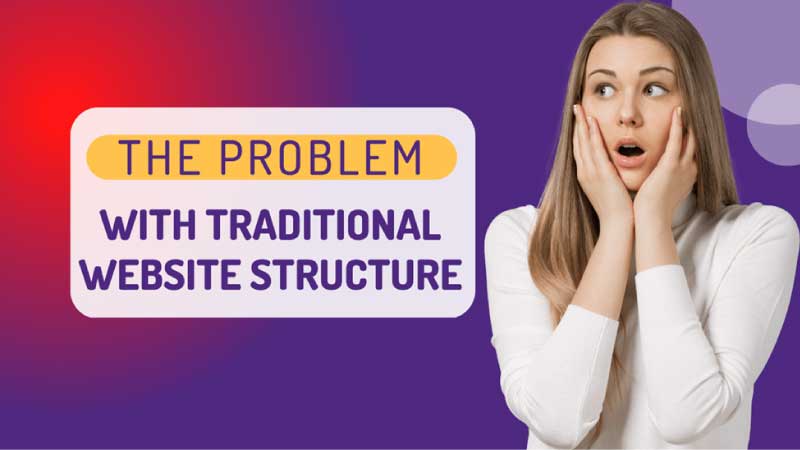Table of Contents
ToggleAs a seasoned SEO professional, I understand the importance of creating pillar pages.
At SEO Pillar Master Headquarters, we love to create pillar pages. Enjoy reading our blog post about mastering SEO with pillar pages.
In this blog post, you will understand how pillar pages can be utilized to increase website traffic through topic clusters and cornerstone content optimized for search engine results.
We will explore the process of organizing your content around a single pillar and creating topic clusters that relate to it.
You’ll discover why having cornerstone content is crucial for ranking high on search engine results pages and how internal links can improve user experience.
Additionally, we will cover the process of content mapping and organizing your blog posts into a coherent strategy that aligns with your central pillar.
Finally, we’ll touch on social media’s role in promoting your topic cluster model. Let’s dive in!
Introduction to Pillar Pages

Pillar pages are an important part of SEO optimization for any website.
Pillar pages supply a framework for your material, making it simpler for search engines to identify and rate your website.
A pillar page is essentially a core page that contains detailed information about a specific topic, such as the products or services you offer.
It serves as the foundation of all related content on your website, which can include blog posts, videos, podcasts, infographics, case studies, and more.
When creating pillar pages, it’s important to use descriptive anchor text when adding hyperlinks throughout the page in order to promote its ranking on Google.
This means using keywords that accurately describe what’s being linked to rather than generic phrases like “click here” or “read more.”
Additionally, keyword research tools can be used to identify relevant topics and create clusters around them – this helps ensure each piece of content is connected in some way back to the main topic at hand.
Pillar pages differ from landing pages in that they prioritize providing comprehensive information about a particular subject area, allowing users to access the content quickly and easily without having to navigate too much within your site architecture.
On the other hand, landing pages are more focused on converting visitors into leads or customers through calls-to-action (CTAs).
This distinction between pillar pages and landing pages is important for SEO optimization, as it helps search engines like Google and Bing find relevant content more effectively.
Utilizing descriptive anchor text when adding hyperlinks throughout the page can also help boost its ranking on these search engines.
It is understandable why business owners might be hesitant when it comes time to build out their own set of pillars.
After all, they are investing time and resources into something with no guarantee that it will pay off in terms of increased rankings or conversions down the line.
However, if done correctly following the best practices outlined above, these fears should not prevent businesses from taking advantage of this powerful tool; instead, view them as opportunities for growth and success.
Pillar pages provide a powerful structure for content creation and optimization, allowing businesses to improve their visibility in search engine results.
However, traditional website structures can limit the effectiveness of these pillar pages; let’s explore how this is the case.
Key Takeaway: Pillar pages are an essential part of SEO optimization, providing a strong foundation for related content and allowing search engines to quickly find relevant information. To make the most out of pillar pages, businesses should use descriptive anchor text when adding hyperlinks throughout the page as well as take advantage of keyword research tools to create topic clusters around their main topics. With these best practices in mind, companies can reap the rewards from investing in building up their own set of pillars.
Problem with Traditional Website Structure

Optimizing a website for search engines is an essential component of its success.
Poorly organized websites often lack the structure and hierarchy necessary to achieve high search engine rankings, resulting in poor user experience and low visibility on Google.
Traditional website structures are built around keywords rather than topics, making it difficult for both users and search engines to find relevant content quickly.
When constructing a website, it is essential to create an orderly arrangement of topics that can aid visitors in navigating the site more proficiently.
This can be done by organizing your content into topic clusters and pillar pages – core pieces of content that cover each topic in detail while linking out to related sub-topics or landing pages.
Establishing relationships between different sections of your website can help maintain visitor interest, potentially resulting in conversions.
Using keyword research tools such as Google Keyword Planner or Moz Keyword Explorer, one can spot terms that are associated but not precisely the same.
This will give you a good indication of the topics which should form the basis for each cluster on your site.
Once identified, ensure search engines understand which words are most important within the context of each page’s content by utilizing descriptive anchor text when adding hyperlinks throughout.
With this savvy SEO strategy in place, you’ll be able to maximize user experience and boost rankings on Google.
Traditional website structures can be difficult to navigate and often lead to poor search engine rankings.
However, by organizing your website around core topics using keyword research tools and descriptive anchor text, you can drastically improve your page rank on Google.
Key Takeaway: By organizing your content into topic clusters and pillar pages, you can create a clear hierarchy of topics to help guide visitors through your site more effectively. This SEO strategy will enable users to find relevant content quickly while helping boost rankings on Google.
The Need for Better Site Organization

Organizing your website around core topics is essential for improving search engine optimization (SEO) and user experience.
Traditional keyword research tools can help identify relevant topics that will increase visibility in search engine results pages (SERPs).
By using descriptive anchor text when adding hyperlinks, businesses can promote their page rank on Google.
The benefits of organizing a website around core topics are numerous.
Organizing a website by core topics can provide the advantage of constructing content into an organized hierarchy, making it simpler for users to locate relevant information quickly.
Additionally, this type of organization allows for more targeted SEO efforts by creating multiple entry points for specific keywords or phrases related to the business’s products or services.
This makes it easier for web crawlers to index the site correctly and thus improves SERP rankings over time.
Using traditional keyword research tools is key when determining which core topics should be included on a website.
These tools allow businesses to determine which words or phrases have high-volume searches associated with them as well as their relative difficulty level when competing against other websites in SERPs.
Once these terms have been identified, they can then be used as focal points within the overall topic structure of the website itself so that content created around those terms has greater relevance both from an SEO perspective and from a user experience (UX) standpoint.
Organizing your website around core topics is essential for achieving higher page rankings on Google and other search engines.
By implementing pillar pages into the mix, you can create a more organized structure that will help boost your ranking even further.
Key Takeaway: Organizing a website around core topics is key for SEO and user experience.
Businesses should use traditional keyword research tools to identify relevant terms that can be used as focal points within their topic structure.
This will help them create targeted content with greater relevance which in turn improves SERP rankings over time.
Pillar Pages

Pillar pages offer an effective solution to traditional website structure by creating a centralized hub that links out to related subtopics within its cluster.
This approach allows businesses to cover broad keywords while still providing comprehensive information on the core topics they are discussing.
Pillar pages create hierarchical maps, which make it easier for both users and search engines alike to understand how different pieces of information relate together cohesively.
What are pillar pages?
A pillar page is a long-form article that covers an entire topic in depth.
It serves as the main source of information about a particular subject and acts as the cornerstone for other content around it.
These types of pages often rank well in search engine results because they provide detailed coverage of one specific area instead of being scattered across multiple web pages or blog posts.
The content should be crafted to ensure readers can quickly recognize the page’s topic and its relevance without needing to navigate multiple web pages beforehand.
Pillar pages offer a more advantageous alternative to traditional landing pages, providing far more context and detail surrounding a given topic.
This makes them much better suited for ranking higher in organic searches than the latter, which are typically too narrowly focused on selling products alone to be recognized as relevant by search engines such as Google or Bing.
By leveraging comprehensive articles that provide valuable information about a particular subject matter, pillar pages can give your website an edge over competitors when people type certain keywords into the search bar looking for answers.
By following these best practices, you’ll increase your chances of ranking high on SERPs and ensure visitors have access to all necessary resources quickly and conveniently.
Utilizing traditional keyword research tools such as Moz Keyword Explorer or Ahrefs Keywords Explorer can help identify relevant topics worth covering on your website further down the line if needed.
The use of pillar pages is a great way to increase visibility in search engine results and help business owners rank higher.
It is essential to differentiate between landing pages and pillar pages prior to taking any action.
Key Takeaway: Pillar pages offer a competitive edge over traditional landing pages, providing comprehensive and detailed coverage on topics to help businesses rank higher in organic searches. By utilizing keyword research tools and creating hierarchical maps of related subtopics, pillar pages can give your website an advantage when people search for answers online.
Difference Between Landing Pages vs Pillar Pages

The purpose of landing pages is to generate conversions through a specific action.
These can include signing up for an email list, making a purchase, or downloading content.
Landing pages, usually utilized in PPC (pay-per-click) advertising campaigns, should be designed with the user experience as a priority and comprise succinct text that quickly explains the advantages to the visitor while motivating them to act.
They should contain concise copy that quickly conveys the value proposition and encourages visitors to take action.
Pillar pages, on the other hand, focus on long-term organic search engine optimization (SEO).
Pillar pages provide comprehensive information about a particular topic and are typically organized into clusters of related content known as topic clusters.
The main pillar page acts as an overview of the subject matter, while individual cluster articles offer more detailed information about subtopics within it.
By creating these internal links between relevant topics, search engines can better understand your website’s structure and rank you higher for related keywords over time.
In addition to using descriptive anchor text when adding hyperlinks throughout your site, optimizing title tags and meta descriptions is also important for SEO success with pillar pages.
Title tags should be unique for each page but accurately reflect what users will find when they click through from SERPs (search engine result pages).
Meta descriptions provide additional context by summarizing what’s included on the page in two sentences or less; this helps draw users in who may not have found it otherwise due to their query being too broad or vague without further explanation from you directly below it in results listings.
The key difference between landing pages and pillar pages is that the latter is designed to cover a broader range of topics in much more depth.
Key Takeaway: Pillar pages are used to optimize organic search engine rankings over time. They provide comprehensive information on a topic, with individual cluster articles providing detailed subtopics within it. To ensure SEO success when using pillar pages, title tags and meta descriptions should be optimized along with descriptive anchor text throughout the site.
Common Fears Associated with Building Pillar Pages

Many business owners hesitate to invest in building pillar pages due to common fears.
Not ranking well against competitors is a major concern, as businesses want their websites to be seen by potential customers.
Without adequate knowledge and resources in SEO strategies, businesses may struggle to generate content that can help them gain a higher ranking in search engine results.
Uncertainty about the effectiveness of pillar pages also contributes to this fear, as there’s no guarantee that creating them will result in higher rankings and more visibility for a company’s website.
Fear 1 – Not Ranking Well Against Competitors:
Many businesses worry that their website won’t appear on the first page of search engine results compared to their competitors.
To fight this fear, businesses should concentrate on producing content of the highest caliber that is optimized with appropriate keywords and phrases pertinent to their field and target market.
Additionally, using backlinks from other websites can help improve your site’s ranking on search engines like Google.
Fear 2 – Lack Of Resources Or Knowledge:
Another common fear associated with building pillar pages is not having enough resources or expertise available when it comes time to actually create them.
Fortunately, many online tools are available to assist businesses that lack technical know-how but wish to implement an effective SEO strategy for their website.
If you still are unsure if you are capable of building pillar pages, you could always hire a company like SeoPillarMaster, which have extensive knowledge of building pillar pages and topic clusters.
For example, tools such as Yoast SEO can provide guidance and suggestions on how best to optimize web pages, so they appear higher in search engine results pages (SERPs).
Key Takeaway: Business owners often fear that their website won’t rank well against competitors and lack the necessary resources or knowledge to build effective pillar pages. However, with a combination of optimized content and backlinks from other websites plus the help of online tools such as Yoast SEO, companies can rise above these obstacles and create successful SEO strategies for their websites.
FAQs in Relation to the Pillar Page

What is a pillar page article?
A pillar page article is a comprehensive, authoritative guide on a specific topic.
It serves as the main source of information and links to other related content pieces (topic clusters).
Pillar pages are designed to rank highly in search engine results by providing thorough coverage of their subject matter.
They typically include images, videos, and other multimedia elements that help make them stand out from regular web pages.
Pillar pages also typically include links to other content pieces, which helps them rank higher in search engine results.
What should be on a pillar page?
A pillar page is a comprehensive, authoritative piece of content that covers a broad topic in detail.
It should include an introduction to the subject and provide clear definitions for any relevant terms or concepts.
The body of the page should then delve into more specific topics related to the main theme, supported by data-driven research and evidence-based insights.
Finally, it should contain a conclusion summarizing key points from throughout the article.
Pillar pages are indispensable for achieving SEO objectives, as they aid search engines in comprehending the purpose of your website and how it can be beneficial to those seeking information related to that particular theme.
How do you write a pillar article?
A pillar article is a cornerstone piece of content that serves as the foundation for an entire topic cluster.
It should provide comprehensive coverage of the main subject, including its history, benefits, applications, and other relevant information.
To write one effectively, research the topic thoroughly and create an outline to organize your thoughts before writing.
Use succinct expressions with distinct titles and subsections to facilitate readers to move through the piece rapidly while supplying adequate information on each point.
Additionally, include internal links throughout the post, which will help increase SEO rankings when indexed by search engines like Google.
What is an example of a pillar content topic?

A pillar content topic is a broad subject area that forms the foundation of an SEO strategy.
It serves as a base for creating related pieces of content, known as “topic clusters,” which are designed to target specific keywords and improve search engine rankings.
Pillar topics should be wide-ranging enough to encompass all facets of the subject comprehensively yet narrow sufficient to concentrate on one or two primary ideas.
Examples could include “Digital Marketing Strategies” or “Small Business Growth.”
Conclusion

Thank you for reading Mastering SEO With Pillar Pages.
Building a pillar page is an effective way to organize your website and improve SEO.
By understanding the differences between landing pages and pillar pages, you can create content that will help boost your rankings on search engines like Google.
Adopting this approach correctly can quickly increase website traffic and improve your organization’s conversion rates.
Increase your website’s visibility and ranking on search engine results from your pages with SEO Pillar Master.
Our advanced pillar page and topic cluster strategies will help you quickly reach the top of Google and other search engines!

We offer the platform where you can surf through articles and blogs to enrich yourself with a wide range of information on technology and trends in and around you. We aim to virtue all our visitors with those skills and assist them in understanding facts and figures about different aspects.








